Streets of Washington, written by John DeFerrari, covers some of DC’s most interesting buildings and history. John is the author of Historic Restaurants of Washington, D.C.: Capital Eats, published by the History Press, Inc. and also the author of Lost Washington DC.
At first glance, this circa 1880 view of E Street NW between 13th and 14th Streets seems like any other old-time street scene. A jumble of 19th century storefronts crowd a busy street. Yet in the decades after the Civil War, this block, affectionately known as “Rum Row” for its many saloons, was one of Washington’s liveliest and most notorious. Possibly a dozen or more pedestrians can be seen as “ghosts,” grouped in pairs or lounging in doorways, reduced to fleeting blurs by the photograph’s slow exposure time. Though still going strong at the time of this photo, the decadent culture of Rum Row would eventually be stamped out by righteous city officials in the name of progress–just as the infamous “Strip” on nearby 14th Street would similarly be eradicated 100 years later.
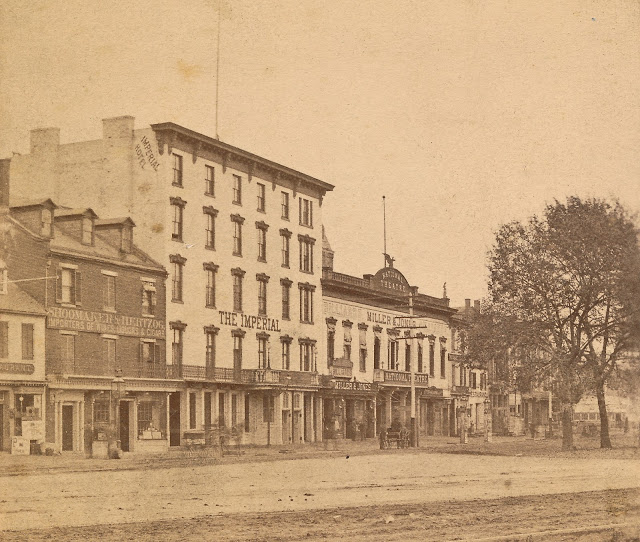
Author’s collection.
Originally a line of federal town houses, Rum Row changed character dramatically during the Civil War, when soldiers swarmed the streets of Washington looking for cheap entertainment. The row’s previously respectable homes and commercial establishments were gradually replaced with saloons and gambling joints, which remained for decades to come. The row’s central location made it the rendezvous for all elements of society. “On the row a man met and mingled with the elite, the bon-ton, the busy man-about-town, the Bohemian, the poet laureate, the soldier of fortune, and everything but the bootlegger, a type that at that date had not come into existence,” wrote The Washington Post in 1921. Read More
Streets of Washington, written by John DeFerrari, covers some of DC’s most interesting buildings and history. John is the author of Historic Restaurants of Washington, D.C.: Capital Eats, published by the History Press, Inc. and also the author of Lost Washington DC.
It’s now a desolate patch of land–a parking garage over a buried stretch of Interstate 395 waiting to be redeveloped. But the site at the northwest corner of 2nd and I Streets NW has an impressive history. Cresting a gentle hill, the view toward the Capitol from this spot once was commanding. This is where a stately row of three grand townhouses known as “Douglas Row” once stood. They were homes to senators, mayors, businessmen, Civil War generals, and even a U.S. president. They also served as a hospital during the Civil War and as an orphan asylum. But as the neighborhood declined in the 20th century, the prestige vanished. Tourists once stopped and read historical markers on these buildings, but one by one they were demolished. Now, nothing is left to mark this site’s remarkable past.
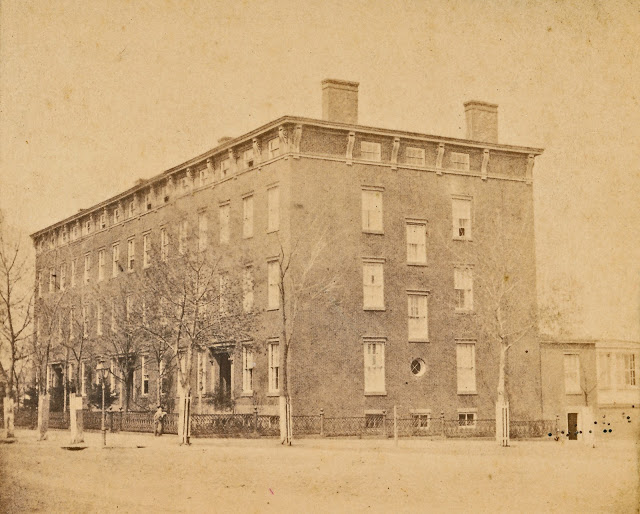
Late 1860s view of Douglas Row (author’s collection).
The first settler in this area was a Captain Samuel Burch, a prominent early Washingtonian who built a country house nearby in 1812. The area was known as “Burch’s Hill” for much of the 19th century as a result. But little else was here until 1851, when Stephen A. Douglas (1813-1861), the Illinois senator and famous rival of Abraham Lincoln known as the “Little Giant,” purchased two blocks of undeveloped land–the block where Douglas Row would be built as well as the one on the other (south) side of I Street. Other than Burch’s house, few structures had been built in this area; the roads had not even been graded or clearly marked. Though just a few blocks north of Massachusetts Avenue, this was unmistakably “country.” At the time, Douglas was entering his second term as senator from Illinois, and he must have seen this hilltop as a perfect, bucolic location, just outside of the city, to build “a comfortable and convenient temporary residence for himself and his family during his service in the Senate,” as he later explained. Read More
Streets of Washington, written by John DeFerrari, covers some of DC’s most interesting buildings and history. John is the author of Historic Restaurants of Washington, D.C.: Capital Eats, published by the History Press, Inc. and also the author of Lost Washington DC.
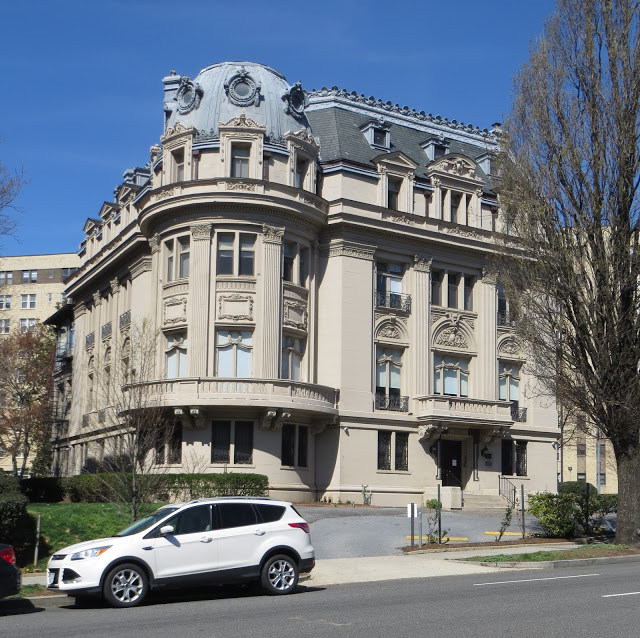
(photo by the author)
The powerful and influential Mary Foote Henderson, whom we’ve previously profiled, commissioned an impressive collection of palatial houses on Meridian Hill in the early years of the 20th century. One of the most prominent of these is the imposing Beaux-Arts mansion at the corner of 16th Street and Kalorama Road NW, which originally served as the French Embassy when it was completed in 1907. This well-preserved building, now home to the Council for Professional Recognition, is a striking expression of Henderson’s vision of Washington as an elegant equal to Paris, with Sixteenth Street its Champs-Élysées. Read More
Streets of Washington, written by John DeFerrari, covers some of DC’s most interesting buildings and history. John is the author of Historic Restaurants of Washington, D.C.: Capital Eats, published by the History Press, Inc. and also the author of Lost Washington DC.
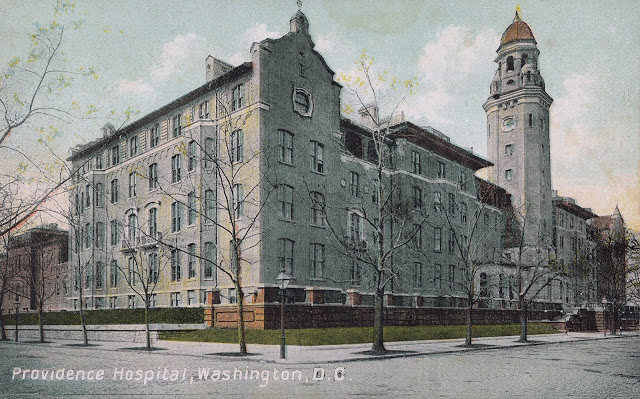
Providence Hospital on Capitol Hill, circa 1910 (author’s collection).
Just a few blocks south of the Library of Congress once stood the city’s largest and most prestigious hospital, founded in the urgent, needy days at the dawn of the Civil War. Because the modern Providence Hospital is now located in Brookland, it can be easy to forget how important this institution was for the rapidly growing central city in the late nineteenth and early twentieth centuries. Providence pioneered modern hospital practices at a time when Washington sorely needed them. Read More
Streets of Washington, written by John DeFerrari, covers some of DC’s most interesting buildings and history. John is the author of Historic Restaurants of Washington, D.C.: Capital Eats, published by the History Press, Inc. and also the author of Lost Washington DC.
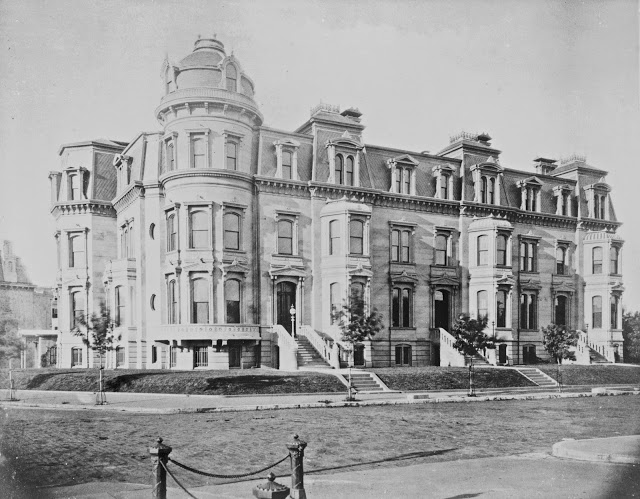
Shepherd’s Row, circa 1880. The Shepherd Mansion is on the left. (Source: Library of Congress).
The stately former mansion of “Boss” Alexander Shepherd on the northeast corner of Connecticut Avenue and K Street NW was one of the most prominent of the great houses that lined K Street during the Gilded Age. Designed by famed architect Adolf Cluss, the house was an emphatic expression of wealth and power. While Shepherd lived there for only a few years, its prominence in Washington’s social life endured for another half century as diplomats and industrialists made it their home and held lavish parties in its ornate reception rooms. “Palatial in size and fittings, magnificently furnished, an example of the union of great wealth and noble tastes,” The Washington Post concluded in 1899.
Alexander Shepherd
The rise and fall of Alexander Robey Shepherd (1835-1902), one of the most important figures in D.C. government in the post Civil War era, is a well-known story, but only recently has a complete biography of this complex individual been published. John P. Richardson’s Alexander Robey Shepherd: The Man Who Built the Nation’s Capital offers a balanced and clear-eyed view of a man who has been vilified as often as he’s been celebrated. Read More

Photo by PoPville flickr user StreetsofWashington
“Here’s a wonderful photo of an early Woodies delivery van parked at the loading ramp of the Woodies building downtown on 10th Street. For a history of Woodward & Lothrop, see here.”
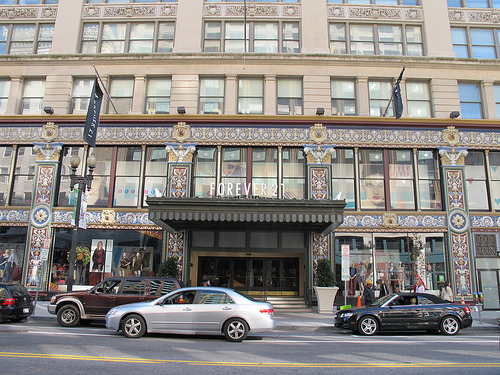
when it got painted in 2011
Streets of Washington, written by John DeFerrari, covers some of DC’s most interesting buildings and history. John is the author of Historic Restaurants of Washington, D.C.: Capital Eats, published by the History Press, Inc. and also the author of Lost Washington DC.
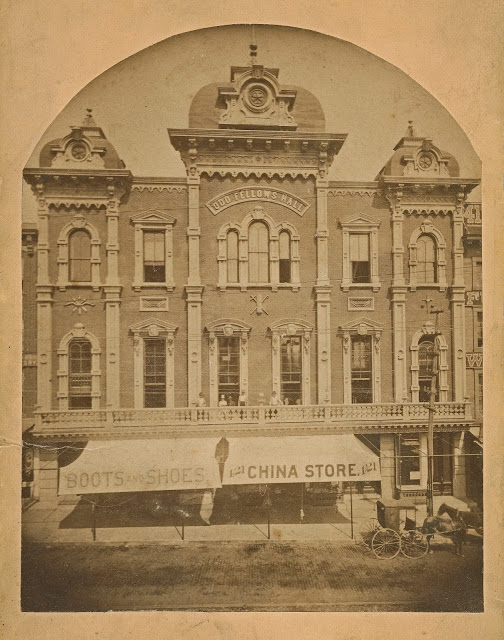
The Odd Fellows Hall, circa 1880. The two ground floor tenants are Asa U. Hazelton’s Boot and Shoe store on the left and the Webb & Beveridge China and Glass store on the right (author’s collection).
The Independent Order of Odd Fellows Temple, standing at 419 Seventh Street NW downtown, represents the rare persistence of a private organization at the same D.C. address for more than 170 years. The IOOF built their first hall at this location in 1845; today they still hold meetings here in the building they completed in 1917. Their previous hall, an ornate Victorian palace, was the scene of many social activities in the late 19th century but has rarely been captured in photographs.
The Odd Fellows are a benevolent fraternal society devoted to charitable works. The group began in England as “an organization of mechanics and laboring men, united for social purposes and to aid its members to obtain employment, as well as to assist them pecuniarily, when in need,” according to the group’s 1888 history. Like the Masons, the Odd Fellows were known for secret rituals, colorful uniforms and insignia, and elaborate ranks and degrees. The first American Odd Fellows lodge was founded by Thomas Wildey (1782-1861), a London blacksmith who came to America in 1817, in Baltimore in 1819. Odd Fellow lodges spread steadily throughout the United States after that, with over one hundred established by the 1830s. The first Washington, D.C., lodge was formed in 1827, and a Grand Lodge for the District of Columbia was established the following year. At least half a dozen separate lodges were formed throughout the District in the first half of the 19th century. Read More
Streets of Washington, written by John DeFerrari, covers some of DC’s most interesting buildings and history. John is the author of Historic Restaurants of Washington, D.C.: Capital Eats, published by the History Press, Inc. and also the author of Lost Washington DC.
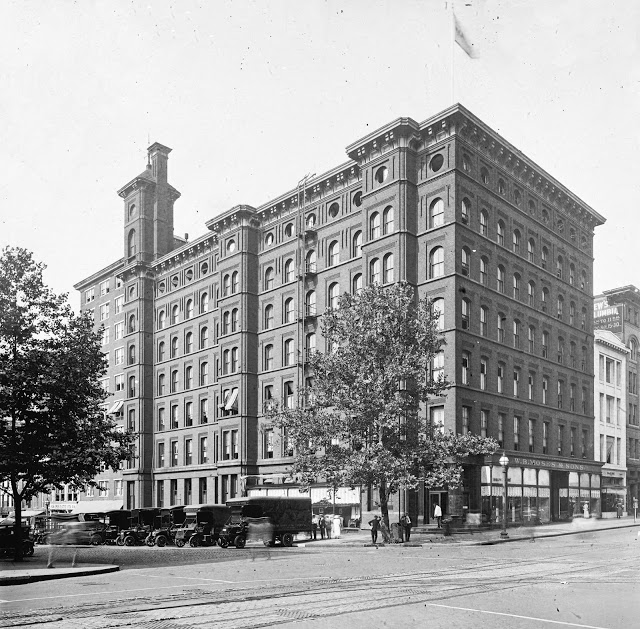
W.B. Moses and Sons store at 11th and F Streets NW, circa 1915 (source: Library of Congress).
“Sell Furniture Earth Over” was the headline in The Sunday Star in November 1908 profiling the W.B. Moses and Sons firm headquartered at 11th and F Streets downtown. By that time the company was well established as “the largest exclusively retail furniture carpet, upholstery, drapery, bedding and wall-paper house in America,” as one promotional book put it. Elegant W.B. Moses furnishings, many of them manufactured right here in the District, graced hundreds of homes throughout the Washington area and as far away as Panama City, Panama. Though the firm disbanded in 1937, antiques collectors still find mahogany chairs, dressers, and tables sporting the W.B. Moses label. Even the Senate Reception Room, one of the most richly decorated spaces in the U.S. Capitol, is fitted out with elegant Flemish oak benches custom made by W.B. Moses in 1899. Read More
Streets of Washington, written by John DeFerrari, covers some of DC’s most interesting buildings and history. John is the author of Historic Restaurants of Washington, D.C.: Capital Eats, published by the History Press, Inc. and also the author of Lost Washington DC.

The 100-year-old former Columbia Hospital for Women as it appears today (photo by the author).
The Columbia Hospital for Women and Lying-in Asylum was founded in June 1866 as a “hospital and dispensary for the treatment of diseases peculiar to women, and a lying-in asylum [maternity hospital], in which those unable to pay therefor shall be furnished with board, lodging, medicine, and medical attendance gratuitously.” Located at 25th and M Streets NW, just off of Pennsylvania Avenue, the hospital finally closed its doors in June 2002, ending an eventful 136-year history of serving Washington women from all walks of life.
Hospitals in the 19th century were charitable institutions that supported those who could not afford to have doctors visit them in their homes. Washington at the dawn of the Civil War had virtually none, aside from the recently-founded Saint Elizabeths asylum for the mentally ill in Southeast. Providence Hospital on Capitol Hill, organized by the Daughters of Charity of Saint Vincent de Paul (and profiled in Lost Washington, DC), was the first general public hospital, but it took in mostly war-related cases and could accommodate very few D.C. residents. Read More
Streets of Washington, written by John DeFerrari, covers some of DC’s most interesting buildings and history. John is the author of Historic Restaurants of Washington, D.C.: Capital Eats, published by the History Press, Inc. and also the author of Lost Washington DC.
Ed. Note: This was originally printed in 2011 but just came across my facebook last week, thanks to John for being kind enough to let us repost this great story here.
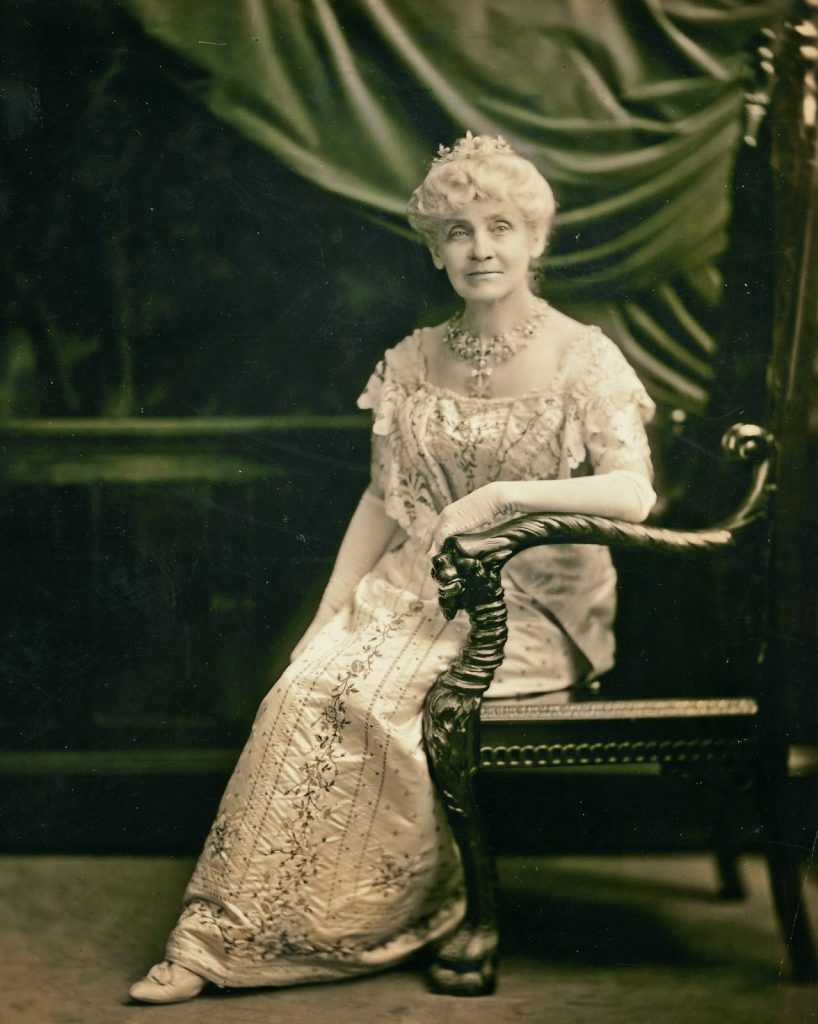
Mary Foote Henderson, circa 1923 (author’s collection).
The Gilded Age, from the 1870s until the 1910s, was a unique period in Washington’s history. The city attracted many nouveaux riches who were drawn by the fact that upper-class Washington society in those days was wide open to anyone with lots of money, a circumstance not found in other major Eastern cities. Of all the wealthy people who moved to Washington to exert power and influence in the Gilded Age, one of the most powerful and influential was a woman, Mary Foote Henderson (1846-1931), who turned her City Beautiful dreams into reality along upper 16th Street. Read More

